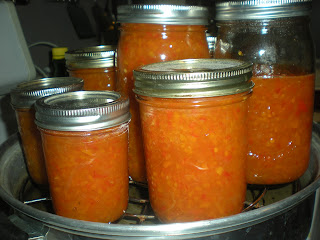We were lazy this Thanksgiving. The appetizer we shared with our families involved zero preparation. We simply opened jars, did a bit of slicing and dicing, and viola - complete! As the holidays approached, we realized we had done a lot of pickling and fermenting this summer. We decided to share a platter of salty, sweet, bitter, and sour flavors. And so, this year, we are especially thankful for healthy, organic produce and for the steamy summer nights we dealt with it all over gigantic cups of iced coffees. Those memories are ones we'll never forget because there really is nothing as romantic as two sweaty adults in a closet-sized kitchen with water canners heating up the already 90+ degree house. Thankful, we are.

Our pickle tray consisted of:
balsamic onions
sour pickles
spicy sliced carrots
dill rat-tail radishes
sweet pepper marmalade served with cream cheese and crackers
pickled spring garlic
On Thanksgiving day, while the Packers won their 11th game this season, some braver family members filled snack plates with pickles. During Lappsgiving (what we've begun to affectionately call our second Thanksgiving), we chatted while delighting in these finger foods while we sipped glasses of wine. Zero preparation, and tons of taste. Pickling a variety in the summer and serving these foods up for holidays could easily become a tradition.
As always, for "Lappsgiving," we made the holiday menu from the current issue of
Vegetarian Times. This year's "French twist" menu was not as scrumptious as that in
2009 or
2010, but it was still pleasing to our palettes.
The foods we decided to make were:
 |
| Salad of Shaved Fennel, Oranges, and Candied Pecans (YUM!) |
 |
| Spiced Balsamic Beet Compote (DOUBLE YUM...a definite keeper!) |
 |
| Seiten Timbales with Chestnut-Champignon Stuffing |
...and, of course, we made the same dessert we always make for Thanksgiving:
Ginger Sweet Potato Pie.
 |
Ginger Sweet Potato Pies
|
Mostly because I don't want to forget either the candied pecan recipe or the spiced balsamic beet compote recipe, I'm going to share them here.
First, the
candied pecans. These would go well in virtually any fall salad.
Ingredients:
1/2 cup pecans, halved and quartered
1 Tbs. pure maple syrup
1/2 tsp. sugar
1/2 tsp. salt
1 pinch cayenne pepper
Instructions:
1. Preheat oven to 400 degrees F. Toss pecans with maple syrup in a small bowl. Add sugar, salt, and cayenne pepper. Toss to coat.
2. Spread nuts on baking sheet, and roast 10 minutes or until crispy and aromatic.
3. Cool for 10 minutes.
And, now for a new favorite appetizer, which is sure to turn up again and again in our house. We liked it over goat cheese on a sourdough baguette, but my parents liked it over cream cheese. This is a great way to use a lot of beets!
Spiced Balsamic Beet Compote
Ingredients:
1/2 cup golden raisins (we used dates because that's what we had, but I bet raisins would be even better!)
2 large beets (about 3 cups)
2 Tbs. olive oil
1/2 tsp. garam masala or curry powder
2 shallots (we used one onion and one clove of garlic)
2 Tbs. balsamic vinegar
2 tsp. sugar
1 tsp. salt
Instructions:
1. Cover raisins with boiling water, and let stand 30 minutes.
2. Cook beets in large pot of boiling water for 10 minutes, or until tender. Drain and set aside.
3. Heat oil in large skillet over medium heat. Add spice, and cook 20 seconds. Add shallots (or garlic and onion), and saute 20 minutes. Stir in beets, raisins, vinegar, sugar, salt, and 1/2 cup water.
4. Cover, and simmer 20 minutes, or until compote is thickened. Cool.






 ]
]











































